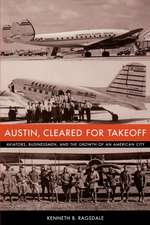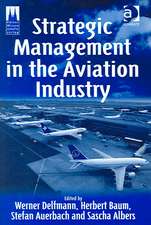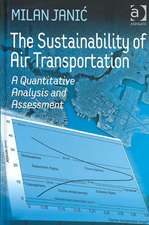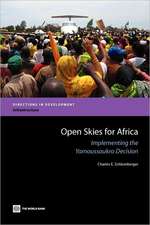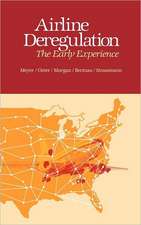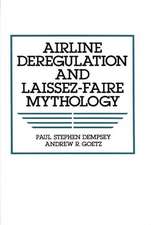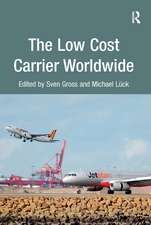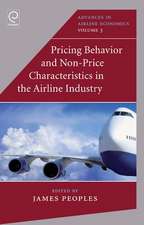Aviation Business Strategy: The International Library of Essays on Aviation Policy and Management
Autor Lucy Budd, Stephen Isonen Limba Engleză Hardback – 23 oct 2019
One of the most significant developments in aviation business strategy over the last four decades has been the emergence and expansion of low cost carriers and the implications that this business model has had for the sector in terms of competition, route offering, service innovation and profitability. Central to these discussions are issues of cost and the need to manage yields. This raises the issue of pricing, elasticity, and price discrimination, all of which are of relevance to passenger airlines, air cargo operators and airports.
Policies of air service deregulation and liberalisation have fundamentally changed the market structure of airlines and airports. As a result of new airlines entering the market place, many incumbent carriers sought to protect and grow their market share by reconfiguring their network into a hub and spoke operation and merging with, or acquiring their competitors. Another strategy airlines can use to increase their network presence, market power, and obtain enhanced economies of scale and scope is to enter into a strategic alliance with another carrier. Membership of an alliance enables a firm to access new markets that would previously have been difficult and/or expensive to operate into and help to overcome (at least in part) ownership restrictions, a lack of traffic rights to a particular country and markets with limited demand.
Deregulation and liberalisation have also changed the competitive nature of the airline market and led to a change in the ownership and control of airports and airlines with many moving from the public to the private sector. The increasingly competitive and contestable market, combined with commercial imperatives to generate a return on investment, means that airlines and airports are incentivised to grow their business through marketing and enhanced customer loyalty. Airlines helped to pioneer the development of customer loyalty schemes and the resulting frequent flyer programmes have become a standard aspect of many full service airline operators’ product offerings. However, increased competition and business model innovation have prompted a reconfiguration of these schemes with some low cost operators now incorporating elements of frequent flyer schemes.
Preț: 1242.30 lei
Preț vechi: 1746.26 lei
-29% Nou
Puncte Express: 1863
Preț estimativ în valută:
237.74€ • 258.15$ • 199.70£
237.74€ • 258.15$ • 199.70£
Carte tipărită la comandă
Livrare economică 22 aprilie-06 mai
Preluare comenzi: 021 569.72.76
Specificații
ISBN-13: 9781472451613
ISBN-10: 1472451619
Pagini: 342
Dimensiuni: 174 x 246 mm
Greutate: 0.73 kg
Ediția:1
Editura: Taylor & Francis
Colecția Routledge
Seria The International Library of Essays on Aviation Policy and Management
Locul publicării:Oxford, United Kingdom
ISBN-10: 1472451619
Pagini: 342
Dimensiuni: 174 x 246 mm
Greutate: 0.73 kg
Ediția:1
Editura: Taylor & Francis
Colecția Routledge
Seria The International Library of Essays on Aviation Policy and Management
Locul publicării:Oxford, United Kingdom
Cuprins
Volume 3 Aviation Business Strategy
Introduction
Part I Market structure
Introduction
Part I Market structure
- Z. Liu and E. L. Lynk, ‘Evidence on Market Structure of the Deregulated US Airline Industry’, Applied Economics, 31, 9, 1999, 1083-1092.
- M. Dresner and M. W. Tretheway, ‘Modelling and Testing the Effect of Market Structure on Price: The Case of International Air Transport’, Journal of Transport Economics and Policy, 26, 2, 1992, 171-184.
- R. M. Rubin and J. N. Joy, ‘Where Are the Airlines Headed? Implications of Airline Industry Structure and Change for Consumers’, The Journal of Consumer Affairs, 39, 1, 2005, 215-228.Part II Revenue, Cost and Pricing
- D. Gillen and W. Morrison, ‘Bundling, Integration and the Delivered Price of Air Travel: Are Low Cost Carriers Full Service Competitors?, Journal of Air Transport Management, 9, 2003, 15-23.
- C. A. Piga and N. Filippi, ‘Booking and Flying with Low-cost Airlines’, International Journal of Tourism Research, 4, 2002, 237-249.
- V. Bilotkach, A. A. Gaggero and C. A. Piga, ‘Airline Pricing Under Different Market Conditions: Evidence from European Low-Cost Carriers’, Tourism Management, 47, 2015, 152-163.
- J. Stavins, ‘Price Discrimination in the Airline Market: The Effect of Market Concentration’, The Review of Economics and Statistics, 83, 1, 2000, 200-202.
- M. Brons, E. Pels, P. Nijkamp and P. Rietveld, ‘Price Elasticities of Demand for Passenger Air Travel: A Meta-analysis’, Journal of Air Transport Management, 8, 2002, 165-175.
- F. Alamdari and S. Fagan, ‘Impact of the Adherence to the Original Low-cost Model on the Profitability of Low-cost Airlines’, Transport Reviews, 25, 3, 2005, 377-392.
- B. Graham and T. M. Vowles, ‘Carriers within Carriers: A Strategic Response to Low-cost Airline Competition’, Transport Reviews, 26, 1, 2006, 105-126.
- G. Francis, I. Humphreys and S. Ison, ‘Airports’ Perspectives on the Growth of Low-cost Airlines and the Remodelling of the Airport-airline Relationship’, Tourism Management, 25, 2004, 507-514.
- A. Graham, ‘How Important are Commercial Revenues to Today’s Airports?’, Journal of Air Transport Management, 15, 2009, 106-111.
- R. G. Kasilingam, ‘Air Cargo Revenue Management: Characteristics and Complexities’, European Journal of Operations Research, 96, 1996, 36-44.Part III Mergers and Acquisitions
- S. A. Morrison, ‘Airline Mergers, A Longer View’, Journal of Transport Economics and Policy, 30, 3, 1996, 237-250.
- E. H. Kim and V. Singal, ‘Mergers and Market Power: Evidence from the Airline Industry’, The American Economic Review, 83, 3, 1993, 549-569.
- R. Merkert and P. Morrell, ‘Mergers and Acquisitions in Aviation – Management and Economic Perspectives on the Size of Airlines’, Transportation Research Part E, 48, 2012, 853-862.
- P. Forsyth, H.-M. Niemeier and H. Wolf, ‘Airport Alliances and Mergers – Structural Change in the Airport Industry?’, Journal of Air Transport Management, 17, 2011, 49-56.Part IV Global airline alliances
- T, H. Oum and J.-H. Park, ‘Airline Alliances: Current Status, Policy Issues, and Future Directions’, Journal of Air Transport Management, 3, 3, 1997, 133-144.
- T. H. Oum, C. Yu and A. Zhang, ‘Global Airline Alliances: International Regulatory Issues’, Journal of Air Transport Management, 7, 2001, 57-62.
- J.-H. Park, ‘The Effects of Airline Alliances on Markets and Economic Welfare’, Transportation Research Part E, 33, 3, 1997, 181-195.
- N. Adler and K. Smilowitz, ‘Hub-and-spoke Network Alliances and Mergers: Price-location Competition in the Airline Industry’, Transportation Research Part B, 41, 2007, 394-409.Part V Marketing and Customer Loyalty
- J. C. Driver, ‘Developments in Airline Marketing Practices’, Journal of Marketing Practice: Applied Marketing, 5, 5, 1999, 134-150.
- D. C. Gilbert, ‘Relationship Marketing and Airline Loyalty Schemes’, Tourism Management, 17, 8, 1996, 575-582.
- S. Gössling and J. H. Nilsson, ‘Frequent Flyer Programmes and the Reproduction of Aeromobility’, Environment and Planning A, 42, 2010, 241-252.
- R. Klophaus, ‘Frequent Flyer Programs for European Low-cost Airlines: Prospects, Risks and Implementation Guidelines’, Journal of Air Transport Management, 11, 2005, 348-353.
- K. J. Mason, ‘Marketing Low-cost Airline Services to Business Travellers’, Journal of Air Transport Management, 7, 2001, 103-109.
Notă biografică
Lucy Budd is Professor in Air Transport Management and Stephen Ison is Professor of Air Transport Policy at De Montfort University, UK.
Descriere
The world’s commercial aviation industry comprises a complex and highly diverse range of businesses with different forms of governance, ownership, management structure and organisational philosophies. The essays in this volume address issues of market structure, focusing particularly on changes in the aviation industry that have resulted from policies of deregulation, as well as revenue, cost and pricing, airline mergers and acquisitions and the reasons for and characteristics of global airline alliances.





